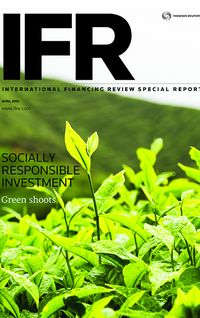The Green Bond Principles have gained widespread support since their initial publication in 2014, although they have deliberately stopped short of a single definition of what constitutes green.
Voluntary standards do not have a good reputation in the financial services industry. Generally drafted by the same practitioners that are expected to abide by them, they have been widely criticised for being light-touch without any real teeth, and have been cast as indirectly responsible for the multiple conduct scandals that have come to light in recent years.
It may seem surprising, then, that as the burgeoning Green bond market has evolved, its protagonists have put their faith in a short set of voluntary principles as the central mechanism to protect the interests of investors and support the further growth of the market.
It is, however, the simplicity and lack of statutory clout that gives the so-called Green Bond Principles (GBP) their inherent value, according to those that drafted them.
“The principles were never intended to be an all-encompassing code for the market, but rather to provide the information needed by investors to make good decisions and to do so in a manner that is transparent, has a high degree of integrity and serves to increase the confidence of investors,” said Michael Eckhart, global head of environmental finance and sustainability at Citigroup.
Eckhart was one of the original architects of the principles back in 2013, along with peers at Bank of America Merrill Lynch, JP Morgan and Credit Agricole. As the pace of Green bond issuance had picked up, it became apparent that the lack of any standard documentation might deter new entrants and inhibit the growth of the market.
The issue of a US$1bn bond in February 2013 by the World Bank’s International Finance Corporation to support climate-friendly projects in the developing world – at that time the largest Green bond on record – became a turning point.
Citigroup was one of the placement agents for the bond and Eckhart recalls that it was immediately oversubscribed. He took the opportunity to engage with the bank’s sales teams and others in the market to determine what was making Green bonds so popular and how the market might evolve further.
“When we started looking at this in 2013, we found a lot of corporates and municipals that were interested in Green bonds but had no guidelines or best practice document to refer to. Our aim was to come up with something that would protect the integrity of the Green bond market and avoid any opportunity for abuse,” said Eckhart.
Swift publication
The first iteration of the GBP was published within months. Recognising the pressure from issuers and investors to have something in place quickly, the drafting committee elected to publish what they had agreed upon, in January 2014, and then to create a governance framework and review process so that the principles could be regularly updated. A first review was completed in 2015, and a second will take place in the coming months.
The current version runs to just six pages and contains little more than 2,000 words, but practitioners believe it has maintained a sensible balance between setting out key standards for Green bond issuance without being so prescriptive that the market’s potential for growth may be compromised.
The four central pillars of the principles set out how the proceeds of a Green bond should be used, how issuers should disclose their decision-making to determine project eligibility, how proceeds should be managed, and how the use of funds should be reported. But the principles deliberately leave plenty of room for interpretation and set no strict eligibility criteria for Green bonds.
“The principles have sometimes been criticised for not defining exactly what constitutes a Green bond, but I think that is right because they were drafted by finance experts rather than green experts, and the definition of green can vary significantly by geography, for example, and technology evolves rapidly,” said Eila Kreivi, director and head of capital markets at the European Investment Bank and chair of the GBP executive committee.
“The principles will remain best practice recommendations rather than hard rules because it is very difficult in a field like this to have global rules that apply to everybody in all circumstances without hindering the development of the market,” Kreivi added.
As the principles stand today, issuers are obliged to disclose key information but investors are ultimately left to judge for themselves whether a bond meets relevant green criteria, just as they must independently determine the risks and rewards associated with any investment. That is a point on which some believe the principles should never shift.
“There has been some call for a certification regime to validate Green bonds, but that is not the way the bond market works. Companies declare that to the best of their judgment, a bond is green, and investors must make their decisions on that basis. The principles make sure investors always get the necessary information to make that judgment,” said Eckhart.
The scope of the principles may never move beyond such thresholds, but regular review remains a priority for all involved. Shortly after the first version was published in 2014, the International Capital Market Association was appointed secretariat to the GBP, and a formal governance framework was put in place.
The executive committee now comprises 24 institutions, with eight investors, eight issuers and eight underwriters. A published list of GBP members runs to more than 100 entities, in addition to a separate and growing pool of observers, highlighting the momentum the principles have gained since they were first published.
“When ICMA got involved in 2014, there was a clear need to formalise the processes and leadership around the principles, so we put in place an executive committee to represent the market, lead the annual update process and promote the principles more widely,” said Nicholas Pfaff, senior director and secretary to the GBP at ICMA.
The second edition of the principles, which was published at the first annual GBP conference in May 2015, added a high-level definition of Green bonds and updated the broad categories of eligible projects. It also expanded on the external assurance issuers should obtain to confirm their alignment with the key features of Green bonds.
Next iteration imminent
With the next annual meeting scheduled for June 2016, work on the third edition is already well advanced. And while participants are reticent to commit to specific changes at this stage, the scope of the review could be fairly wide ranging. Six working groups have been established to focus on relevant issues, including assurance, defining green, impact reporting, internationalisation of the GBP, policy issues and database providers.
“Over the past year, there has been a shift to focus on some of the more difficult, technical issues associated with Green bonds and we now have a family of working groups drilling into greater detail on those core issues. They will make proposals for updates in June and then continue to think about more long-term strategic aspects,” said Pfaff.
The third edition of the GBP will come at a time of increasing focus on environmental, social and governance (ESG) factors across the investment community. Investment research provider Morningstar recently launched a sustainability rating system to allow investors to evaluate the ESG credentials of around 21,000 mutual funds and exchange-traded funds.
Meanwhile, the Financial Stability Board has established a task force on climate-related financial disclosures to develop recommendations for consistent and reliable disclosures by companies. Chaired by Michael Bloomberg and comprising senior market participants, the task force is expected to deliver its report for consultation by year-end.
“In 2016, the focus of the industry has moved on considerably and there is now a lot more discussion of disclosure, because if institutions are compelled to disclose their carbon footprint or sustainable development goals, then there is a lot more information available to make qualified decisions about ESG investments,” said Ulrik Ross, global head of public sector debt capital markets and sustainability at HSBC.
“The next 18 months will be game-changing, as efforts to formalise disclosure and ratings by the Financial Stability Board, Morningstar and others progress. This will change the dynamics of the bond market and put a much bigger focus on sustainability,” Ross added.
Against that backdrop, the GBP look set to retain a critical role in promoting disclosure and transparency in the issuance of Green bonds. While the detail of this year’s review and future reviews will rest with the executive committee and the various working groups, the industry has clearly committed itself to the principles as a means of maintaining high standards of integrity.
It is difficult to judge whether the Green bond market would have continued to flourish in the same way without the GBP, but most participants believe there is a large body of issuers and investors that would not have tapped the market without some kind of best practice document. It is also believed to have been instrumental in eliminating so-called ‘greenwash’, whereby bonds were sometimes marketed as being green without genuine green credentials.
“The number of Green bond issuers that have come to market since the start of 2014 shows that there was already pent-up demand but they wanted a guiding document to be in place. Green bonds don’t necessarily have to fit the same criteria in every jurisdiction, but standardisation in the issuance and disclosure process gives everyone greater confidence,” said Marilyn Ceci, managing director and head of Green bonds at JP Morgan.
To see the digital version of this special report, please click here
To purchase printed copies or a PDF of this report, please email gloria.balbastro@thomsonreuters.com



